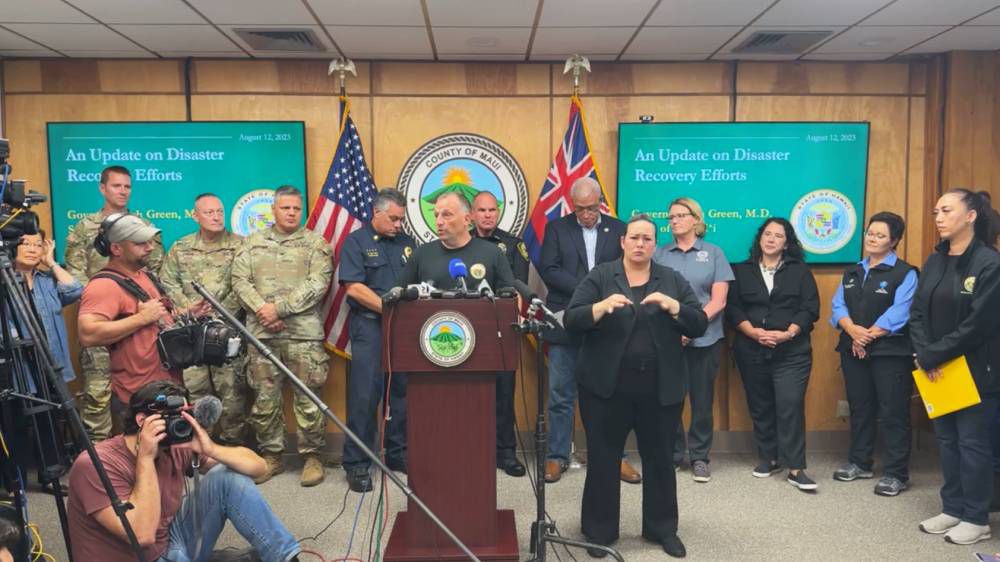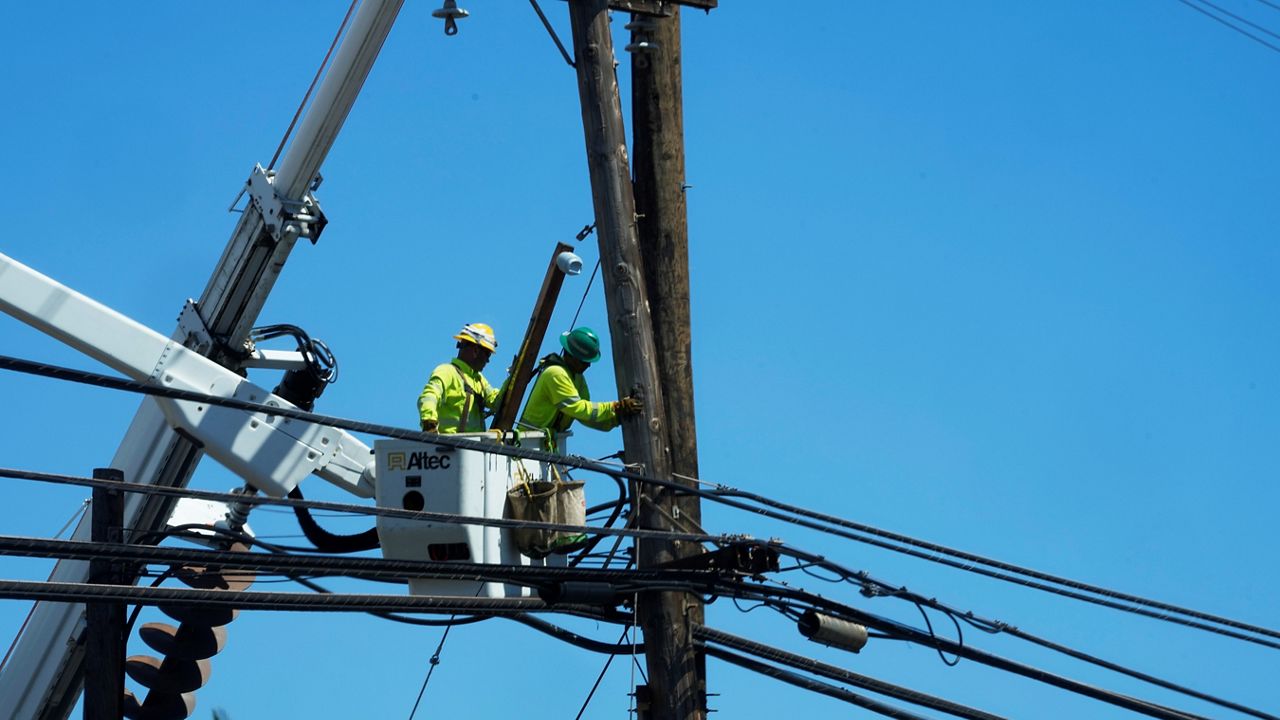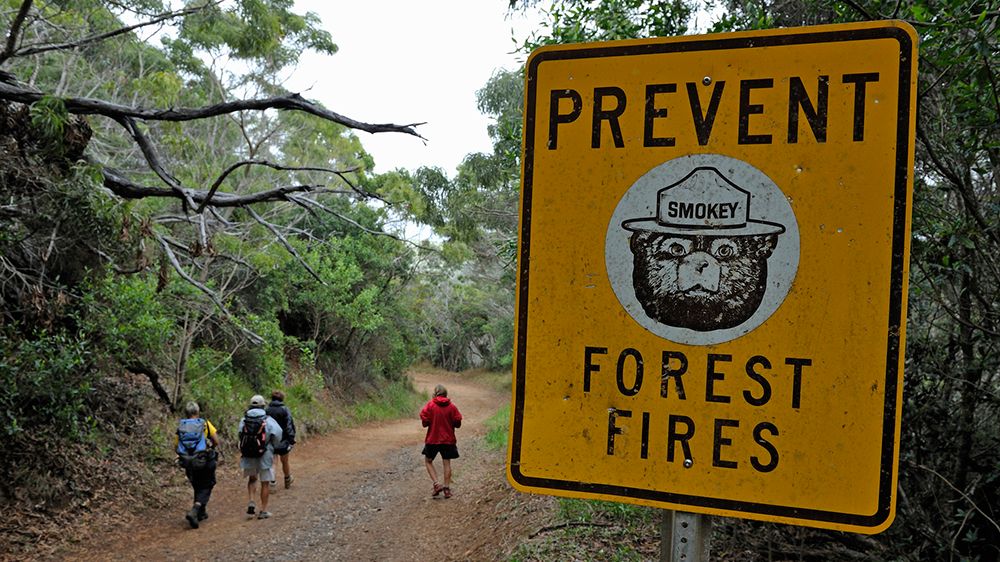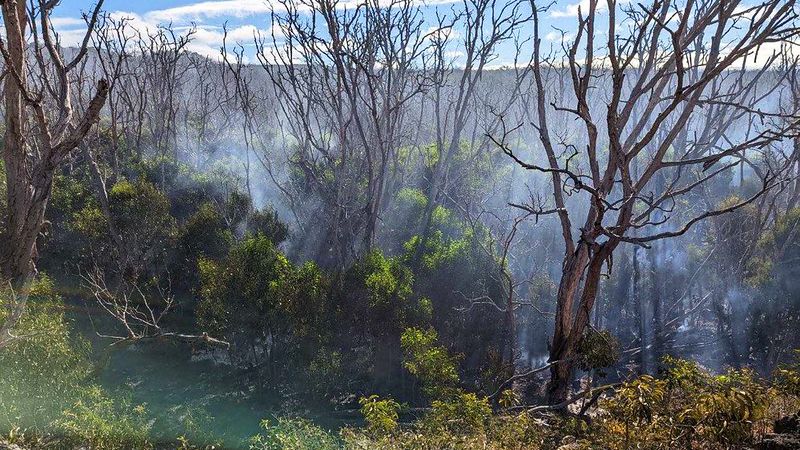Hawaii officials are urging the public to be patient as Maui County deals with an unprecedented natural disaster.
Gov. Josh Green, Maui County Mayor Richard Bissen and multiple officials from county and federal agencies brought media up to date on the latest for Lahaina at a Saturday press conference.
“This is the largest natural disaster we’ve ever experienced. It’s going to take an incredible amount of time to recover from,” Gov. Green said.
Death toll, damage and losses from the fire
The governor confirmed 89 fatalities Saturday, making it the deadliest U.S. wildfire in over a century. Maui County later raised the confirmed death toll to 93.
The wildfire caused destruction or damage to 2,200 structures, with 86% of them being residential in West Maui. In Kula, 544 structures have been “exposed,” with 96% of them residential.
“The losses approach $6 billion,” Green said.
“We ask for a lot of understanding about traveling into the (historic area of Lahaina town), and the reason for that are the health consequences. We have to go with caution. There are heavy metals there,” he continued. “The recommendations are to avoid structures because they could still fall on people. And we’ve lost so much life already.”
He said thousands of pounds of food and water have come from The Ritz-Carlton, Kapalua, as a distribution point. The public has also donated thousands of pounds of food from around the state “and frankly, from around the country.”
Green said Hawaiian Electric has restored one of three transmission lines, which means 3,700 customers are now getting power. One concern about getting residents into hotel rooms is that they need to make sure the hotels have power. “Because we don’t want to move people from a place where they do have, and you have working bathrooms, to a place that they don’t,” said Green. That’s coming online quickly, he said.
He also mentioned nearly 15,000 passengers have flown out per day with people still at Kahului Airport deciding when “they feel they’re ready to go.
“A lot of people are stunned,” Green said. “They’re traumatized; traumatized by what they see people are going through.”
Emergency response and housing
Fifty National Guardsmen arrived on Saturday, Green said, with many more to come in the coming days. Their arrival “makes it more possible for us to protect certain areas so people can do their work at ground zero, (as well as) open up the road to make it easier for all of us to travel to the places that we’re familiar with,” he continued. “That’s a big part of this operation.”
He explained the state has put together a temporary housing task force that will work with federal agencies. They’ve secured 1,000 rooms, 500 of which will go to families that have been displaced because of the fire and 500 rooms that will initially go to other personnel.
Long-term rentals will be coming as Mayor Rick Blangiardi directed the Department of Planning and Permitting to suspend the 30-day short-term vacation rental mandate to increase the availability of temporary housing on Oahu.
“All of that’s going to be covered,” said Green. “It’s going to be covered by the state, some of it is going to be given charitably. And then finally, FEMA will cover a great deal of the cost.”
Maui Mayor Richard Bissen said the recovery effort is being led locally with the support of the federal government. “We know we have a lot to do. We’re doing our very best to address the needs and the concerns. We’re moving from the immediate fire response to long-term recovery,” he said.
Bissen said operations would shift according to the community’s needs, such as moving food distribution points closer to communities where people are sheltering in place. The county has established a family center and Red Cross hotline to connect families. They’re also working to get more first responders, medical care and community partners into impacted areas.
The highway closure point is being managed to ensure that access into the impact zone is limited to critical responders and those who are providing necessary goods and services. He said they are also expanding flight services to help visitors return home to open resources for residents.
“These folks (National Guard personnel) are here to help us,” said Bissen. “This event is larger than us. And we need and welcome their help. We’re going (on) a long road to recovery, but I assure you we will recover working together.”
Federal Emergency Management Agency Administrator Deanne Criswell said she came to see firsthand the full devastation that Maui has experienced, as well as what the challenges are going to be and what resources are going to be required moving forward.
After speaking with officials, she wanted to talk with the people who had been impacted. Criswell went to the War Memorial shelter and spoke to survivors who shared their experiences.
“I heard their harrowing stories of escape, evacuating, then evacuating again, a car that was caught on fire, and they got into somebody else’s car,” she said. “What I always find, even during these incredibly tragic times, is the resilience of a community to come together and support each other. And that’s what I saw at the shelter today.
“Even amidst all this tragedy, there were neighbors helping neighbors, and it’s this human spirit coming together that always gives me hope that we are going to be able to rebuild and make sure that these communities that have been impacted, will become even better in the future,” Criswell said.
FEMA has 150 people on the ground, with more coming that include search-and-rescue teams with more dogs that will be on Maui in a couple of days, said Criswell.
President Biden’s disaster declaration gives FEMA the ability to bring in additional federal partners that include the Small Business Administration, the Army Corps of Engineers, the Department of Defense and others.
She also encouraged those who have been impacted by the fires to register for FEMA assistance by calling 1-800-621-FEMA. FEMA personnel are also at the shelters and can assist residents in registering.
“I know that this is a very troubling time and there are still many unknowns for people who are out there,” said Criswell. “But what I would ask is that you don’t give in to despair. Because we need you. Maui needs you, Hawaii needs you, your neighbors need you. And I believe that every day is going to get a little bit better.”
Fire status and victim identification
Maui County Fire Department Chief Brad Ventura updated the media on how firefighters are working to extinguish flare-ups and contain fires in Lahaina, Pulehu/Kihei and Upcountry Maui. He said the goal now is to ensure everybody is safe and not to let the fires expand anymore.
“There are still tons of hazards in the area (Lahaina),” Ventura said. “We highly encourage you to stay out. As things continue to fall and off-gas, there are toxic particulates around that people shouldn’t be breathing.”
Maui Police Chief John Pelletier weighed in on what they needed from the public.
“Patience, prayers and perseverance,” he said. “That’s what we need. We need that from everyone.”
He said many residents live on deer and fish and also grow kalo. “That’s how our families survive here. And the fire took that out. So we’ve got a lot of work we’ve got to do.”
Pelletier spoke of the loss, many of whom are unidentified.
“We’re going as fast as we can. But just so you know, 3%, that’s what’s been searched with the dogs. We’ve got 12 more dogs on the way. We just made that request and FEMA made that happen. Think about how hot and how humid it is, and we can only go as fast as the animal can go,” Pelletier said.
He urged those who are missing family members to get a DNA test that would assist in identifying loved ones.
In response to a later question from media, Pelletier said the remains they’re finding “is through a fire that melted metal.” The identity of each victim must be done through rapid DNA testing.
“We know we’ve got to go quick. But we got to do it right,” said Pelletier. “When we pick up the remains, they fall apart. So when you have 200 people running through the scene yesterday, that’s what you’re stepping on. I don’t know how much more you want me to describe it.
“Give us a little bit of time to contain that. Because we gotta make 89 notifications, and coming from a place that had to make 58 … I understand the pain this is going to take, and we’re not done with 89. So just understand what this thing is because none of us really know the size of it yet. Everybody wants a number. You want it fast? Or you want it right? We’re gonna do it right,” emphasized Pelletier.
Earlier in the press conference, Pelletier had mentioned doing things the right way, doing things “pono.” He said, “We’re going to do it with respect. We’re going to do it with aloha. We’re going to do it with dignity. Because we are Hawaii, and we are Maui.”
Brigadier General Steve Logan, commander of the Hawaii Army National Guard, was appointed to a special position as “dual status commander” that was developed after Hurricane Katrina. Together with Colonel David Hatcher and Colonel Dave Fielder, their mission is to help Maui residents.
“We are here in a support role,” he emphasized. “We’re here to support Mayor Bissen, his staff and the rest of the county agencies. Not to take charge and not to take control.”
Speaking for the U.S. Coast Guard was Captain Aja Kirksey, sector commander of the U.S. Coast Guard in Honolulu. She shared that since Tuesday, the Coast Guard has been deploying teams to search for survivors and rescuing those in distress. They are also closely monitoring impacts on the marine environment by the fire, conducting marine assessments to identify potential hazards and pollution.
Over three days, over 300 Coast Guard personnel responded to the fire along with three cutters, two aircraft, multiple boats, divers, and specialized teams have responded to the fire. Crews were able to save 17 individuals, rescuing 40 more together with their partners.
U.S. Fire Administrator Dr. Lori Moore-Merrell explained that the Lahaina fire was a “low-to-the-ground fire” that was grass-fed, moving very fast. She said since 2017, the U.S. has experienced the top 10 fires of all fires in the nation.
Future of Lahaina
“This (Lahaina) now has superseded the Camp Fire in 2018,” said Moore-Merrell. “That was the deadliest. This fire now has become the deadliest in the last 10 years.”
Following words given by U.S. Senator Mazie Hirono, U.S. Representative Jill Tokuda shared a memory of visiting Lahaina.
“I went to the same place I go every time I go to Lahaina, which is the public library. And it is gone,” she said. “But I will tell you what gave me infinite hope. The wooden sign in front of the library is there, almost untouched.
“This is an absolute tragedy we’re dealing with as a family here in Hawaii. People feel it across this country and across this world. Please know this too, that we feel the urgency as we walk through those streets. As we talk to people, we feel that same struggle, that same anxiety, that same desire to do absolutely everything that we can in our power to make sure our loved ones, our families, are taken care of,” Tokuda said.
In response to a question from the media about when residents will be allowed back into Lahaina, Mayor Bissen said it’s not a time element, it’s a decision based on safety. The county is currently now allowing anyone into the impacted zone (downtown Lahaina). They were allowing people whose homes are still intact and who must drive the main road to get to their homes. However, Bissen said they were going into the restricted impact zone.
“It’s not safe, it’s a hazardous area,” said Bissen. We’re not doing anybody any favors by letting them back in there quickly, just so they can go get sick. A lot of what’s happening now is we’re asking for the respect and the dignity of recovering anyone who’s still there. That’s the main thing we’re trying to do right now.”
He said the 10 p.m. to 6 a.m. curfew was also broken. He understands those who live in Lahaina want to return to their homes, but downtown Lahaina will remain closed for a while. Napili, Kahana, Kapalua remain open.
Responding to a comment about residents not wanting another Waikiki, but focusing more on sustainability, Bissen said the community will make that decision, but there are still people who own various properties. “A lot of these are individual decisions — how you want to rebuild your home, how you want to rebuild your business, if you want a business, if you don’t want a business. I’m not sure we get to decide for other people what to build on their property,” said Bissen.
Evacuation orders
In response to a question about no evacuation orders having been relayed to residents, Bissen said time would be better spent on recovery and rebuilding, and an investigation into that would be up to the attorney general.
Green responded that winds were up to 60 mph with gusts up to 81 mph.
“That created an incredibly intense and dangerous circumstance,” he continued. “Having seen that storm, we have doubts that much could have been done with a fast-moving fire like that,” he said.
Speaking about whether volunteers move quicker than the government in response to a question, Bissen said, “Government probably does move slower than a private citizen who runs to the store, buys something and drops it off. We’ve had so many stories of that, but I wouldn’t say one was better than the other.
“They’re working together. Everyone’s coming together … from Molokai, Lanai, using boats getting people over and trying to figure out ways around the closure of the roads. So there’s been a lot more to this,” he said.
Tourism on Maui amid recovery efforts
When asked about whether remaining visitors on Maui should leave for the time being, Green responded, “At this point, I don’t think visitors are impairing anything that we’re doing, blocking roads. We do have frustrations about the few visitors who decided they wanted to come and see a site, which we find to be toxic to us as our people have suffered. But that’s very few people.”
Mayor Bissen pointed out that it’s not the number of tourists that residents are upset about; it’s when people are disrespectful, not just on Maui but anywhere they travel. The issue is rude visitors.
“This isn’t Disneyland that’s created for something,” said Bissen. “This is where people live and survive and work.”
Green said a significant consideration is the safety of all first responders dealing with difficult conditions. The other consideration is that for residents and the economy to survive, they will need jobs.
He said during the COVID-19 pandemic, Hawaii did better than other states. “But we did have to balance the fact that when you restrict any travel to a region, you really devastate its own local residents in many ways, more than anyone else,” Green said.
So the plan, he said, is to place residents into hotels so hotels can remain open. The cost will be covered by the state and the federal government. The idea is that those residents will likely be employees of the hotels so they can focus on recovery.
“But we don’t want other businesses to leave and also leave other parts of Maui devastated. That wouldn’t be okay,” said Green. “I will say it’s going to be a very long time before tourism returns for us to anywhere near the levels that was in West Maui. It’s all hands-on deck.”
Support from around the world
Green’s message to people around the world who love Maui: “I just want to say thank you to all of you who have been patient with us and who are covering us so that people across the world can see this place that they love, how it’s struggling and suffering right now, and how, if you value Hawaii, if you love the spirit of aloha, if you love our people as we know you do, not only be patient with the travel but also support us in the future. Support us in believing in us when we welcome you back. That is important to us.”
Green added that people have indeed supported Hawaii, with 70,000 people sending support to one of the organizations that was raising money for the residents on their road to recovery.
“So we will rebuild Hawaii together here and with you. But it’s going to take time,” Green said.





)


